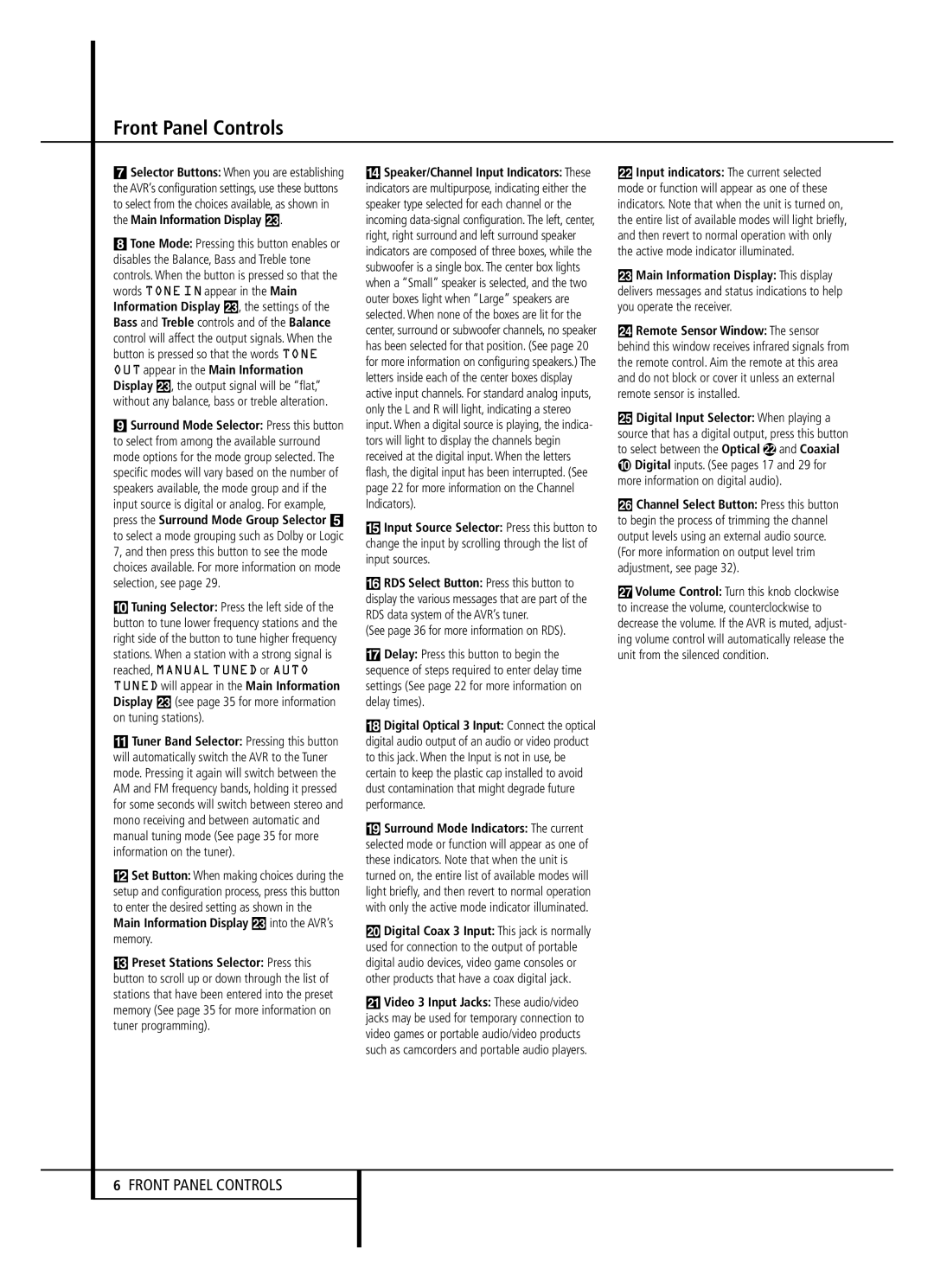Front Panel Controls
7Selector Buttons: When you are establishing the AVR’s configuration settings, use these buttons to select from the choices available, as shown in the Main Information Display Ò.
8Tone Mode: Pressing this button enables or disables the Balance, Bass and Treble tone controls. When the button is pressed so that the words TONE IN appear in the Main Information Display Ò, the settings of the Bass and Treble controls and of the Balance control will affect the output signals. When the button is pressed so that the words TONE OUT appear in the Main Information Display Ò, the output signal will be “flat,” without any balance, bass or treble alteration.
9Surround Mode Selector: Press this button to select from among the available surround mode options for the mode group selected. The specific modes will vary based on the number of speakers available, the mode group and if the input source is digital or analog. For example, press the Surround Mode Group Selector 5 to select a mode grouping such as Dolby or Logic 7, and then press this button to see the mode choices available. For more information on mode selection, see page 29.
)Tuning Selector: Press the left side of the button to tune lower frequency stations and the right side of the button to tune higher frequency stations. When a station with a strong signal is reached, MANUAL TUNED or AUTO TUNED will appear in the Main Information Display Ò (see page 35 for more information on tuning stations).
!Tuner Band Selector: Pressing this button will automatically switch the AVR to the Tuner mode. Pressing it again will switch between the AM and FM frequency bands, holding it pressed for some seconds will switch between stereo and mono receiving and between automatic and manual tuning mode (See page 35 for more information on the tuner).
@Set Button: When making choices during the setup and configuration process, press this button to enter the desired setting as shown in the Main Information Display Òinto the AVR’s memory.
#Preset Stations Selector: Press this
button to scroll up or down through the list of stations that have been entered into the preset memory (See page 35 for more information on tuner programming).
$Speaker/Channel Input Indicators: These indicators are multipurpose, indicating either the speaker type selected for each channel or the incoming data-signal configuration. The left, center, right, right surround and left surround speaker indicators are composed of three boxes, while the subwoofer is a single box. The center box lights when a “Small” speaker is selected, and the two outer boxes light when “Large” speakers are selected. When none of the boxes are lit for the center, surround or subwoofer channels, no speaker has been selected for that position. (See page 20 for more information on configuring speakers.) The letters inside each of the center boxes display active input channels. For standard analog inputs, only the L and R will light, indicating a stereo input. When a digital source is playing, the indica- tors will light to display the channels begin received at the digital input. When the letters flash, the digital input has been interrupted. (See page 22 for more information on the Channel Indicators).
%Input Source Selector: Press this button to change the input by scrolling through the list of input sources.
^RDS Select Button: Press this button to display the various messages that are part of the RDS data system of the AVR’s tuner.
(See page 36 for more information on RDS).
&Delay: Press this button to begin the sequence of steps required to enter delay time settings (See page 22 for more information on delay times).
*Digital Optical 3 Input: Connect the optical digital audio output of an audio or video product to this jack. When the Input is not in use, be certain to keep the plastic cap installed to avoid dust contamination that might degrade future performance.
(Surround Mode Indicators: The current selected mode or function will appear as one of these indicators. Note that when the unit is turned on, the entire list of available modes will light briefly, and then revert to normal operation with only the active mode indicator illuminated.
ÓDigital Coax 3 Input: This jack is normally used for connection to the output of portable digital audio devices, video game consoles or other products that have a coax digital jack.
ÔVideo 3 Input Jacks: These audio/video jacks may be used for temporary connection to video games or portable audio/video products such as camcorders and portable audio players.
Input indicators: The current selected mode or function will appear as one of these indicators. Note that when the unit is turned on, the entire list of available modes will light briefly, and then revert to normal operation with only the active mode indicator illuminated.
ÒMain Information Display: This display delivers messages and status indications to help you operate the receiver.
ÚRemote Sensor Window: The sensor behind this window receives infrared signals from the remote control. Aim the remote at this area and do not block or cover it unless an external remote sensor is installed.
ÛDigital Input Selector: When playing a
source that has a digital output, press this button
to select between the Optical and Coaxial Digital inputs. (See pages 17 and 29 for
more information on digital audio).
ÙChannel Select Button: Press this button to begin the process of trimming the channel output levels using an external audio source. (For more information on output level trim adjustment, see page 32).
ıVolume Control: Turn this knob clockwise to increase the volume, counterclockwise to decrease the volume. If the AVR is muted, adjust- ing volume control will automatically release the unit from the silenced condition.

